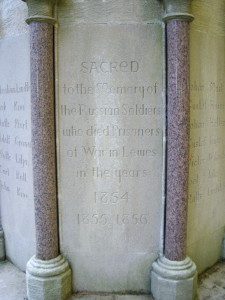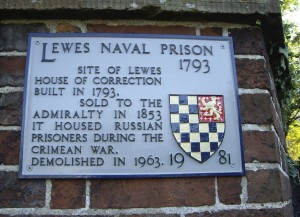Last weekend I visited Lewes to give a lecture on Crime and Punishment at the Lewes Little Theatre, ahead of their forthcoming production of the novel, which opens on 12 October. I had a wonderful time, with a very appreciative and knowledgeable audience, and really interesting discussions with the cast and production team, whose perspectives on Crime and Punishment were thought-provoking in all sorts of ways.
During our visit, Miles Jenner, the director of the play and head brewer at Harveys (brewer, among other fine products, of the Tsar of all the Beers, Imperial Extra Double Stout), took us into the atmospheric and rather overgrown churchyard next to the Little Theatre to show us the monument erected in 1877, on the order of Tsar Alexander II, to honour twenty-one “Russian” prisoners from the Crimean War who died in captivity in Lewes between 1854 and 1856. The Lewes Naval Prison held around 350 prisoners of war, whilst officers were paroled in the town. Conditions were apparently pretty good for the prisoners, who were allowed to go for walks on the Downs, and took up making wooden toys and puzzles, which they sold to the townsfolk, becoming rather well off – they certainly had enough money to make the Tsar’s easter gift of sixpence each for the prisoners to buy hot cross buns look somewhat insignificant. After the soldiers were repatriated at the end of the war, the Senior Constable of Lewes received a letter thanking the townspeople for their kindness and good treatment of the prisoners.
It’s an interesting story in itself (and my thanks to Miles for providing the details), but it has another curious aspect, in that the soldiers weren’t Russian at all, but mainly Swedish and Finnish, as the names on the monument attest. Obviously the Grand Duchy of Finland was part of the Russian Empire in the 19th century, and this article from the Telegraph on the recent refurbishment of the monument explains that the prisoners were captured as part of an attack on the Åland Islands in 1854 that was intended to stop the Russian Empire making use of its Baltic fleet during the Crimean War. So it’s both Russian and not. [updated on 29 September 2013 shortly after initial posting.]
The monument was restored by the Soviet government in 1957, “At the instance of the Friends of Lewes Society,” as one of the panels informs us – the slightly antagonistic tone framing this as a minor intervention in the Cold War. So there’s a story there as well, and it makes me wonder how many places have these curious little Russian connections. Time to turn Russians in London into Russians in Britain?
Photographs by John Levin, licensed under a Creative Commons Attribution-ShareAlike 3.0 Unported License.



Russell Working
/ October 2, 2013I’d love to read the lecture you gave. Is it available anywhere–or let me know if it shows up online.
Sarah Young
/ October 3, 2013I’m planning to post part of the lecture on the blog at some point soon – will let you know when that’s up.
Susanna
/ May 29, 2016Is there a record of these names with photographs. I’m am searching specifically for one man to find his name and discover where and how he died.
He would have been one of those that had been based in Beauport Park in I think 1856.
Any guidance gratefully received.
Susanna
Sarah Young
/ July 3, 2016I’m sorry but I don’t know anything more that could help you at the moment, though will let you know if anything comes up.